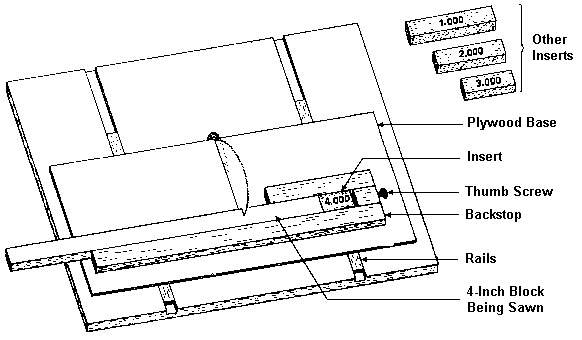
[Home] [Contents] [Figures] [Search] [Help]
[Next Page] [Prev Page] [ Next Chapter] [Prev Chapter]
The second and final sawing operation is to cross-cut these sticks into short stick segments or blocks. For this you will need a small table saw equipped with some special jigs. Much trouble will be saved if the saw makes a smooth cut that requires practically no sanding. The very fine-toothed so-called plywood blades do this. At the first sign of dullness they should be sharpened or discarded. Increased noise, resistance, or inaccuracy of cut are all signs of dullness; and when burn marks start to show the blade is hopelessly dull.
Nearly all puzzles are made of large numbers of identical blocks or sticks. The only way to saw these accurately and efficiently is by using special jigs that you make. Shown in Fig. 206 is a simple and very useful jig for sawing short square sticks and blocks. Its body is a solid piece of plywood that slides on a pair of rails in the miter grooves of the saw. Various inserts adjust the jig for making different sized blocks. The thumbscrew on the right allows for minute adjustments, such as might be necessary when changing saw blades. When correctly adjusted, all cuts should be accurate within plus or minus 0.005 inches.
Fig. 206
A second very useful jig is the one already shown in Fig.
90. With just these two jigs, one can make about half of the puzzles
described in this book. A slightly modified version of the diagonal jig, shown
in Fig. 207, is used to make rhombic dodecahedral blocks. As the stick is
rotated to four different positions, four saw cuts are made, bringing the end to
a pyramidal point. The stick is then advanced a certain distance determined by
the spacer block, and four more shallow cuts are made. In the illustration, the
final cut is being made that severs the finished block from the stock. Thus it
is not necessary to place one's fingers near the saw. For one-inch stock, the
length of the spacers is ![]() plus the saw kerf.
plus the saw kerf.
Fig. 207
A jig for sawing the eight corners from a cubic block to make truncated octahedra is shown in Fig. 208. The same sort of 45-degree cradle is used, but it forms an angle of 35¼ degrees to the miter grooves when viewed from above.
Fig. 208
Notched pieces such as are used in the standard six-piece burr are notched using the jig shown in Fig. 209 in conjunction with a dado blade in the saw. Spacer blocks are used to position the pieces properly.
Fig. 209
For all of the puzzles that use equilateral-triangular sticks, the cuts are made using the simple jig shown in Fig. 210. which holds the sticks at an angle of 54¾ degrees viewed from above. Again, various spacer blocks are used to position the stock correctly.
Fig. 210
There are many other similar special-purpose saw jigs, but the most basic ones have now been described and the reader should be able to figure out the others.
| ©1990-2005 by Stewart T. Coffin For questions or comments regarding this site, contact the chief metagrobologist: |
[Next Page] [Prev Page] [ Next Chapter] [Prev Chapter]